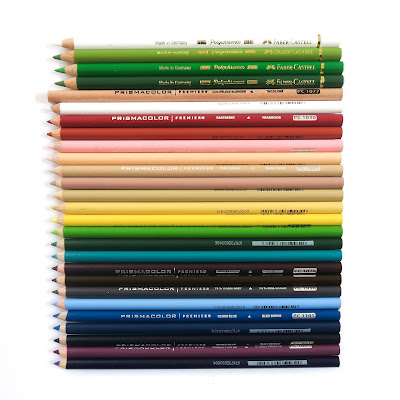As I've been reading tutorials and watching videos, I've kept a list of questions. Those questions then become the search terms for my next lessons. It's worked well in the sense that I've been able to answer some of my questions, but inevitably more questions come up (along with things I want to try and things I don't want to try yet, but eventually might). Today I'm sharing what my list looks like as of right now.

Questions / Problems
1. When using a colorless blender and/or burnisher, does using the same brand as the colored pencils matter? Should I at least be using a blender/burnisher that matches my colored pencils in terms of oily vs. waxy?
2. Should I be using a fixative for Prismacolors? If so, what and when? That link goes to the only one on the Blick site. Is that a good one to use?
3. Does a marker base fill the tooth of paper at all?
4. Is there a way to recover the black lines of a coloring page if you go over them with colored pencil? Can you use the same technique of burnishing the black lines to keep them black like you'd do to keep sections of the paper white?
5. I've heard references to the fact that there's a difference between a "layering pencil" vs a "blending pencil." What does this mean and what are examples of each?
6. Can I prevent crumbs? If no, how do I deal with crumbs? I've seen others use a large, fluffy makeup-style brush to sweep away the crumbs, which I would like to try. I don't know how to google it though. Is it actually a makeup brush? Searches for art brushes bring up paintbrushes.
7. What paper should I use if I want to print a design for coloring AND add a watercolor background?
Things to Try
2. Use a craft knife to pre-draw whiskers, veins of a leaf, etc. or to remove pencil later for wispy hair or fur. I LOVE this version of a craft knife by Fiskars.
3. Start with toned paper in order to work on highlights and shadows.
4. Shade yellows and oranges with purples and magentas instead of browns and greys.
5. Allegedly, the Buff Titanium Caran dAche Luminance pencil is the best blender ever. It's pricy compared to every other blender, but if it's so much better than everything else, I want to try it.
Not For Me (for now, anyway)
2. Electric erasers. Until recently, I had no idea an electric eraser was a thing. I'm 99.9% sure I don't need this, but if I'm wrong, let me know.
3. Posca paint pens. I've seen a lot of colored pencil artists use them for highlights and details over the top of colored pencils. I'm not convinced I need to try this.
4. Collecting sets of colored pencils. I had no idea, but there are people who collect colored pencils, which they may or may not ever use. I wrote down this quote while watching a video because I couldn't believe it. "Coloring is a collecting hobby. You never know what colored pencils might become rare and valuable."
5. Major pre-planning. For better or worse, I like to just start. I can't believe how much time some people put into doing a coloring page before they ever pick up a colored pencil. Testing a few pencils together to pick out a palette ahead of time, sure, that's reasonable. Scanning a page and coloring it with 20+ options to see which one is best before ever using the real page? That's a hard no for me.
6. Powder blender. See #1.
7. Sanded paper. It's primarily for pastels, but people use it for colored pencils. Not me. I hate sand.
Please comment if you have answers, suggestions, or other feedback. Thanks in advance for any help you can give!



Lots of good questions!
ReplyDeleteThose are a lot of questions!
ReplyDeleteI hardly use my colorless blender. I just blend with a lighter or darker shade in the same color family. White and blacks are the shades I always replace so I always buy those when trying a new brand. The colors you need depends on what subject matter you are coloring. I know that using a solvent to blend the base colors will really help get rid of the graininess and quicken the coloring process because you don't have to add as many layers. But I have not tried it because I can't get access to the solvents here in my country. Amazon can't ship it to me (against the law). I use the smallest white Posca paint pen for highlights. It's fluid and opaque. You can also try water-based Sharpie white pen which is probably cheaper for you than the made=in-Japan Posca pens. Or you can try Molotow paint pens which are refillable.
I know you are excited to play with colors but the best thing you can do is limit your color palette and just work on getting your lights, darks and mid-tones right.